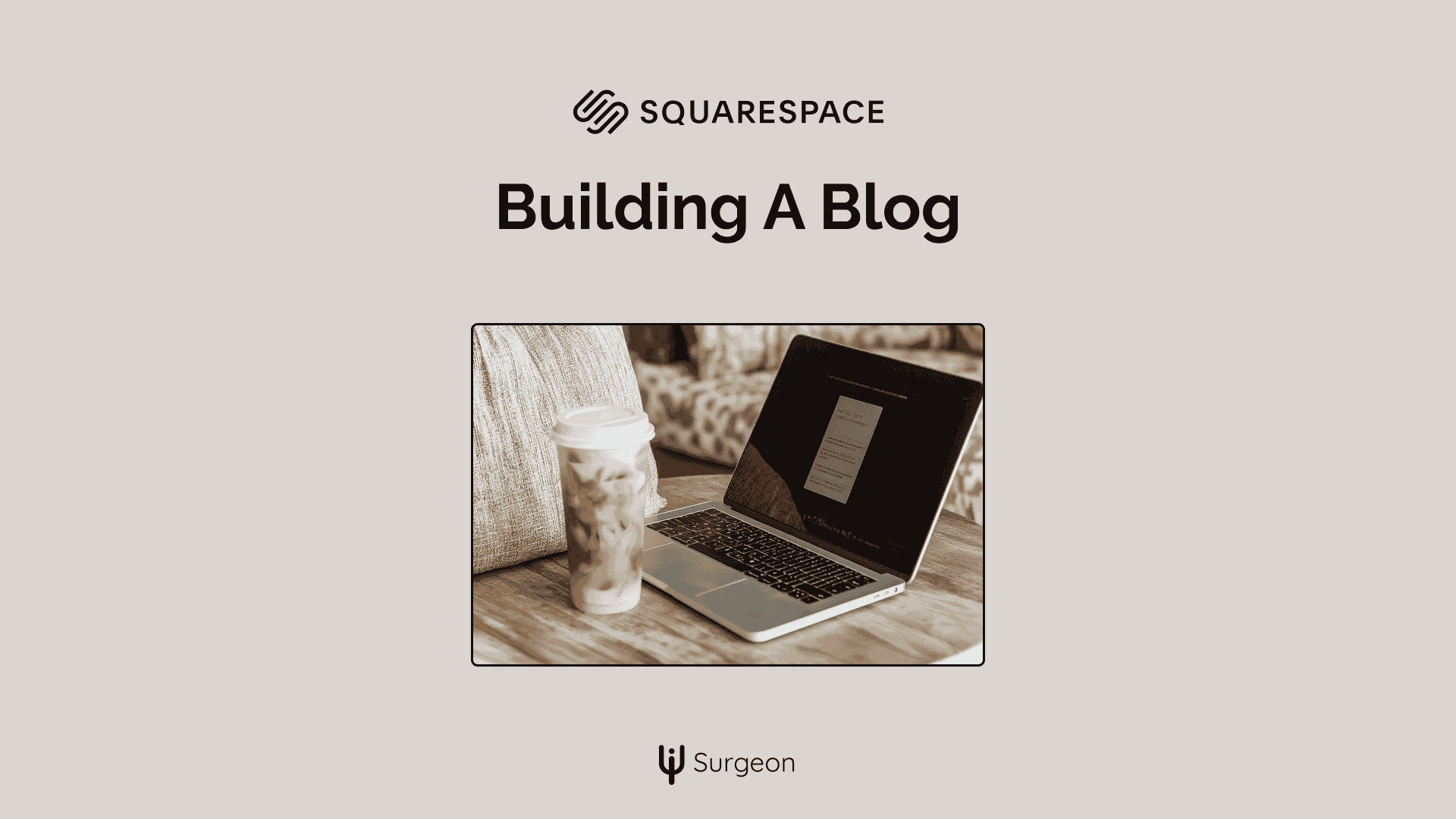Building a blog can be very hard if you don't know what you're doing. It's not just website, but more like a structured system that just happens to be a website
Using a tool like Squarespace can make the process of building this system much easier. You don't have to worry about CMS, coding, meta tags, and detailed SEO. It pretty much handles all that for you.
In this comprehensive guide, I'll walk you through everything you need to know to build a successful blog with Squarespace. Whether you're starting fresh, switching platforms, or creating a professional presence, this guide will serve as your roadmap to Squarespace blogging success.
By the end, you'll have mastered:
- Choosing the right plan and template for your specific needs
- Setting up a professional blog structure and creating compelling content
- Optimizing your blog for growth, SEO, and monetization
But Why Squarespace for Blogging?

Squarespace Overview
How To Build a Squarespace Blog In 2 Minutes
Squarespace stands out as more than just a website builder; it's a comprehensive platform specifically designed with content creators in mind.
It's very very easy to use, extremely beginner friendly, and it takes care of all the dreadful work that comes with managing a blog.
You're probably starting a blog to write, not to make a CMS or learn about JavaScript. This is where Squarespace comes. It takes care of these dreadful tasks so you can focus on writing.
Key advantages include:
1- Intuitive Design Interface
Drag-and-drop functionality. No the need for coding knowledge
Real-time preview allows you to see changes as you make them
Built-in responsive design ensures your blog looks great on all devices
2- Professional Templates
Each template is professionally designed and mobile-optimized
Templates are categorized by purpose, making it easy to find one suited for blogging
Regular updates ensure your blog stays modern and functional
Pre-made drag and drop sections.
3- Integrated Tools
Built-in SEO tools help your content rank better in search results
Analytics provide insights into your audience's behavior
Marketing tools help you promote your content effectively
Not sure if Squarespace is for you? Read this one: Squarespace vs WordPress For Blogging
Is Squarespace Good for Blogging?
Squarespace is an exceptional platform for bloggers, particularly beginners. It offers a comprehensive, user-friendly solution that handles technical complexities, allowing content creators to focus entirely on writing and growing their blog. With professional templates, integrated SEO tools, and zero coding requirements, Squarespace simplifies the blogging process while providing powerful features for content management and website growth.
Key advantages include:
- Intuitive drag-and-drop design interface
- Professional, mobile-optimized templates
- Built-in SEO and analytics tools
- Automatic security and platform updates
- No technical maintenance required
Why Not Use WordPress Instead?

While WordPress dominates the blogging space (powering over 40% of websites!), Squarespace offers distinct advantages:
WordPress Strengths:
WordPress can be better than Squarespace in multiple ways as it has:
- Unlimited customization possibilities
This is both an advantage and a disadvantage of WordPress. - Vast plugin ecosystem
Which is awesome, but can be very frustrating if you don't know what you're doing. - A larger community support because more people use it
Squarespace Advantages:
Squarespace however, takes the disadvantages of WordPress and makes it advantages for them:
- No technical maintenance required
- Built-in security and updates
- Unified support system
- Professional templates that work without you doing anything
When to Choose Squarespace Over WordPress:
If you're looking for something quick, easy, user-friendly and manages everything for you, Squarespace is for you.
- You're a beginner.
- You don't want to worry about managing a website.
- You know nothing about plugins and how they work.
- You want something fast and reliable
- You're more of a designer than a developer
Squarespace For New Bloggers
Squarespace is perfect for new bloggers because:
- You don't need any coding to get started
- It reduces the technical overhead that comes with managing all aspects of a blog
- It includes a guided setup process so you're not just shooting in the dark
- It includes built-in best practices for SEO so you don't have to worry about meta tags and what they are.
New bloggers can benefit from using Squarespace in many ways, most prominent benefits are: Quick setup so you can start as fast as possible, professional look without design knowledge, comprehensive support system.
Choosing the Right Squarespace Plan
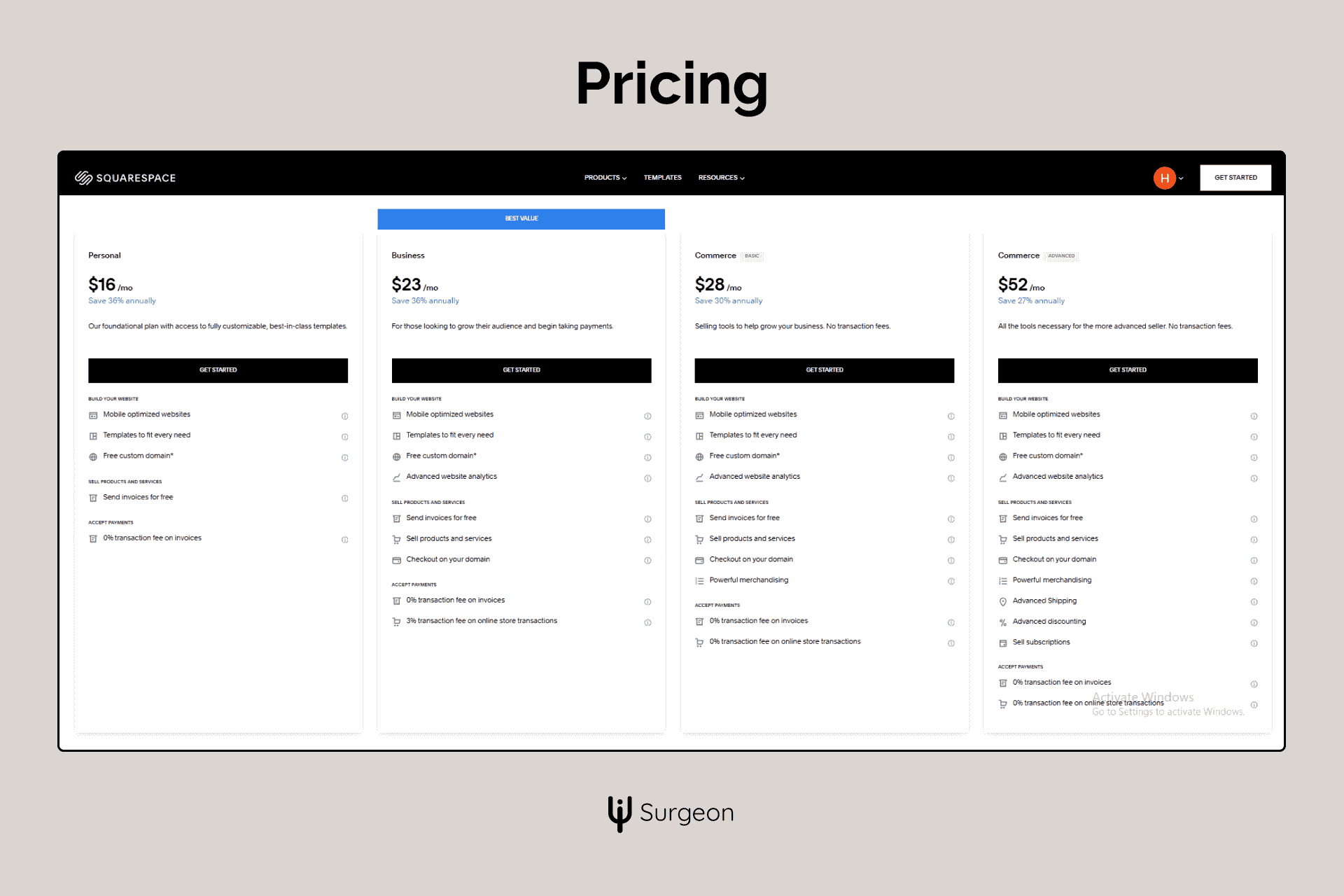
Plan | Cost (Annual Billing) | Best For | Limitations |
Personal | $16/month | Bloggers starting out | Limited e-commerce & analytics |
Business | $23/month | Growing blogs | 3% transaction fee on online sales |
Commerce (Basic) | $28/month | Established blogs with products | - Fewer advanced e-commerce features than Advanced |
Commerce (Advanced) | $52/month | Subscription-Based Blogs | Higher cost for features many bloggers might not use |
Personal Plan ($16/month): Best for Bloggers starting out
Features include:
- Unlimited bandwidth and storage
- Free custom domain for first year
- SSL security
- Basic website metrics
Why choose Personal:
It's cost effective, has most blogging features you'll ever want. It's just enough for single authors if you don't have a team yet.
Business Plan ($23/month): Best for growing blogs
Additional features:
- Professional email from Google
- Advanced analytics
- $100 Google Ads credit
- Complete customization with CSS/JavaScript
Why upgrade to Business:
If you're looking to sell products (digital or physical) this is pretty much for you.
Commerce Basic Plan ($27/month): Best for established blogs with products and sales
Key features:
- No transaction fees
- Point of sale features
- Professional accounts
- Advanced shipping options
When to choose Commerce:
If you're selling a ton of products and the transaction fee surpasses the amount you pay as a subscription!
See more on Squarespace pricing page
Which Plan Is Right For You?
I honestly think that a personal plan is enough for most people. You may need to upgrade if you have other team members or contributors. However, with business plan you get to track your traffic and analytics better. But you're just starting out, you're not gonna need more than what's in the personal plan.
Have I mentioned that they give you a 14-day free trial? So go ahead, play around!
Choosing The Right Domain for Your Blog.
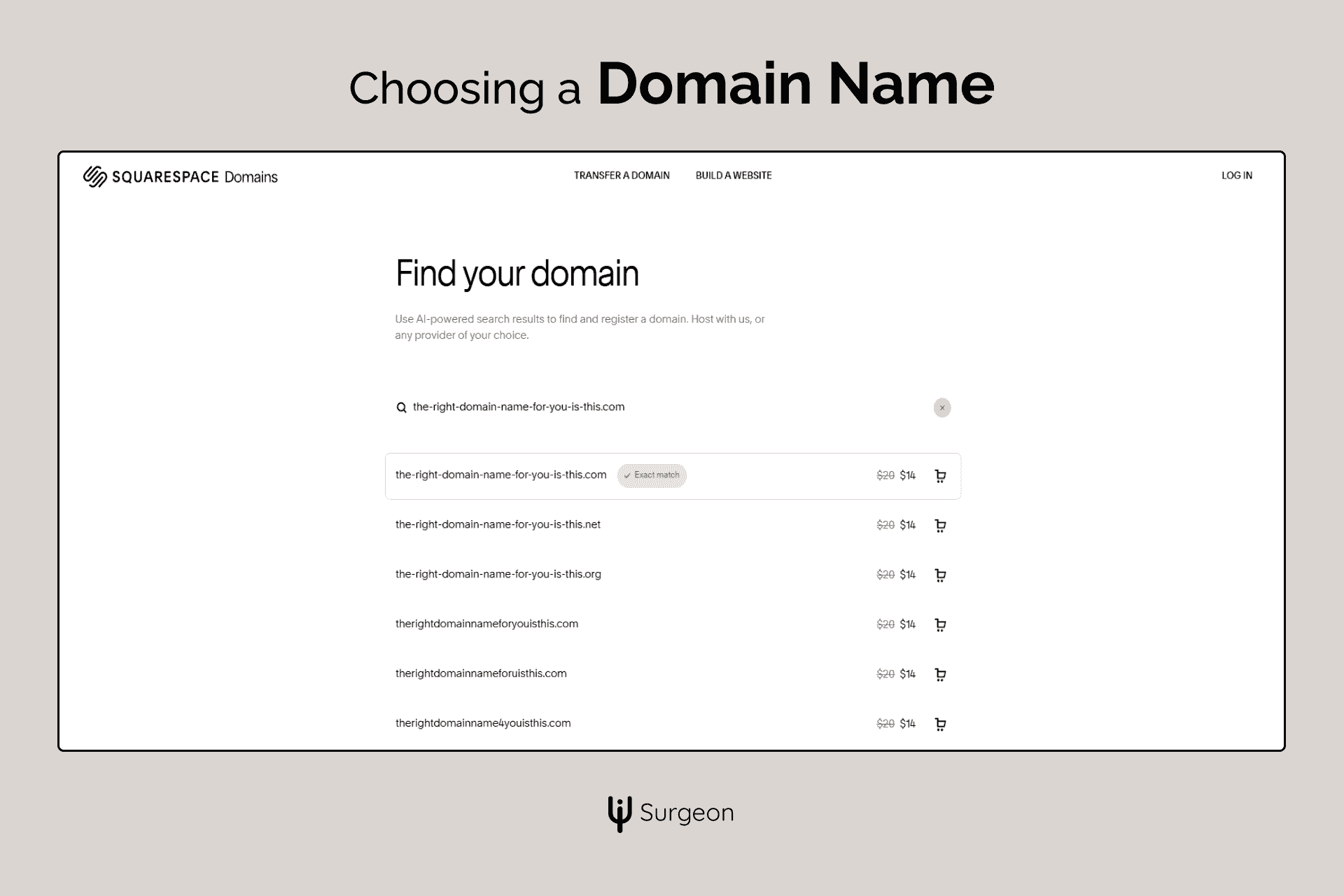
There are things you need to consider before buying a domain for your blog. From domain name to domain health, you need to learn about these things before making your move.
I bought this domain because I thought the name was good (UI Surgeon), but what I didn't consider was how this affects my perceived niche, how Google understands this name, and if my audience will know what it means even.
Does Domain Health Matter?
Yes, domain health is a crucial factor when choosing a domain. Domains that were previously used for spam, blacklisted activities, or low-quality content can carry penalties from search engines. Which can make very difficult for you to make google trust you in the future. Which can make it harder for your blog to rank well on Google, no matter how great your content is.
Before purchasing a domain, always check its history using tools like:
- Wayback Machine to see past versions of the website.
- Google Transparency Report to check if the domain has been flagged.
- Tools like Ahrefs or Moz to analyze the domain's backlink profile. Look for spammy or irrelevant links that could harm your SEO.
Is Your Domain Name Well-Suited For Your Audience?
Your domain name should resonate with your audience and clearly reflect your niche.
Avoid overly clever or vague names that might confuse potential readers (such as UI Surgeon).
You should also avoid pigeonholing yourself into a very specific niche by choosing an overly specific domain name like "teaching-veggie-moms-with-two-children.com".
Instead, focus on names that are:
- Easy to spell and remember.
- Relevant to your blog’s topic or audience.
- Free from unintended negative connotations in different languages.
- Broad enough for other related niches
If your audience doesn’t immediately understand your domain name, you risk losing their interest. For example: "UI Surgeon".
Consider Keywords and Branding
Including a keyword in your domain can help with SEO, but don’t overdo it. Google prioritizes branding and user experience over keyword-stuffed domain names. A strong, memorable brand name is better for long-term success.
For example, if your blog focuses on helping small businesses build websites, a name like "WebDesignToolkit.com" might resonate better than something generic like "BestWebsiteTips123.com."
So just consider your brand name first and then domain best-practices.
What About Domain Extensions?
Don't overthink this one, going with the standard .com can be great for anyone really. However, alternative extensions like .blog, .design, or .co can work well if they align with your niche. Just make sure they don’t confuse your audience.
Final Tips for Choosing the Perfect Domain
- Brainstorm multiple options before settling on a name.
- Check for trademarks to avoid legal issues.
- Verify the availability of matching social media handles.
- Always register your domain with a reputable registrar and enable WHOIS privacy to protect your personal information.
Don't overthink it, it's the first step of you blogging journey so just do this one in a day or a week max if you still haven't figured out your brand name yet.
Free Squarespace Domain vs Your Own
- Free domains offered by Squarespace (e.g., yoursite.squarespace.com) are fine if you don't have any money for a professional domain but it does change the perceived professionalism of your brand.
- Bringing your own domain (e.g., yourbrand.com) gives you a polished brand image and makes it easy to come out as a professional.
Choosing Your Blog Template
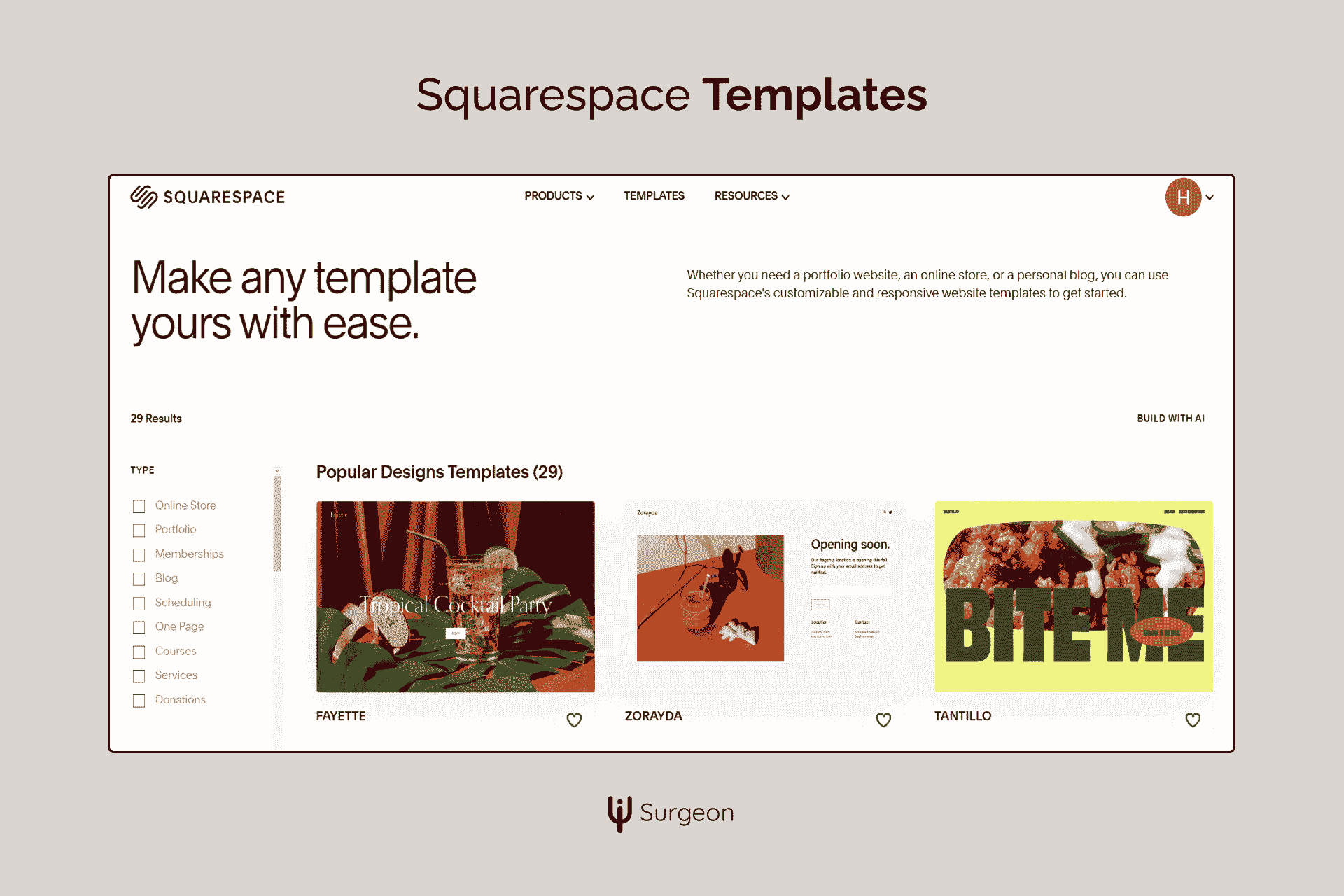
Choosing the right Squarespace template for your blog is probably the most exciting part of this whole process. So allow yourself some time with this step as it could bring huge fulfilment.
If you're going for a template rather than prebuilt site there are things you need to consider before doing so.
Paid VS Free Squarespace templates
Paid templates can be higher quality, less generic, more unique and used by less people. Free Squarespace templates can be faster to set up, and save you some money.
I would highly recommend going the paid route if you're dedicated and have made any progress.
If you're just starting out it's perfectly fine to go with a free template especially because free Squarespace templates are still very professional and user-friendly.
Best Free Squarespace Blog Templates
Here are 3 of my favorite Squarespace blog templates.
They are all user friendly, unique, easy to navigate, easy to set up, and most importantly well-structured for a blog.
1- Fillmore

2- Palmera

3- Harman
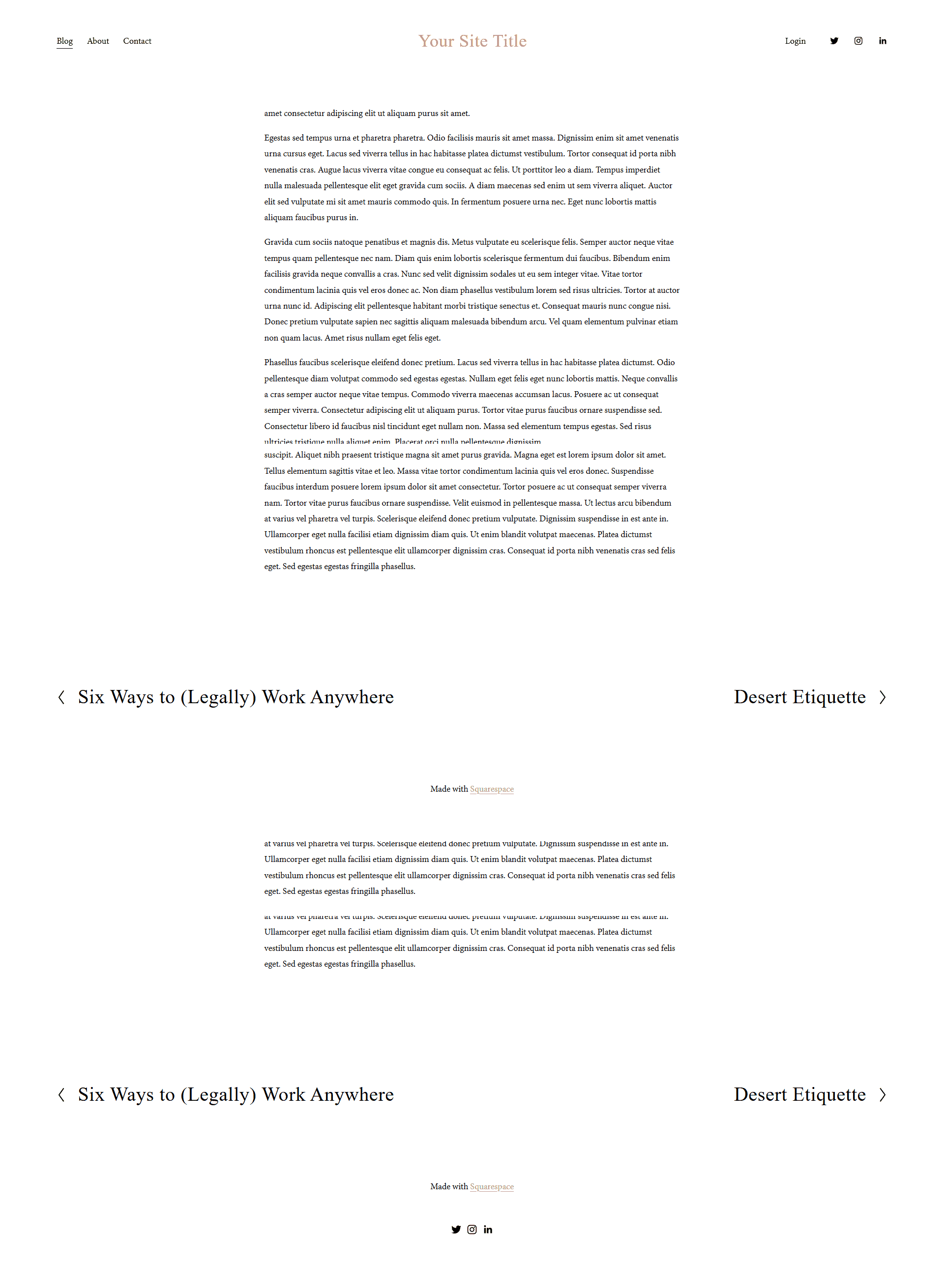
You can find more free blog templates on Squarespace here.
Paid Squarespace Templates
Paid Squarespace templates are designed and built by third-party creators. These templates are created using Squarespace’s platform and are sold on various marketplaces such as Etsy, Creative Market, or independent creators' websites.
They often feature more advanced designs and layouts tailored to specific industries or personal preferences, offering a less generic look without the need to design from scratch.
How Does Buying a Paid Squarespace Template Work?
The process of buying and using a paid Squarespace template is as follows:
- Purchase the Template
You browse through platforms like Etsy or Creative Market and find a template that suits your style or needs. Once you’ve made your selection, proceed to purchase it. - Provide Your Squarespace Account Information
After purchase, the seller typically requests your Squarespace email address (the one associated with your Squarespace account). This allows them to duplicate the template and transfer it to your account. - Template Duplication and Transfer
The seller duplicates the template site on Squarespace and transfers ownership to your account. They will ideally remove themselves as an owner, ensuring you have full control over the website. - Customize the Template
Once the template is in your account, you can start customizing it to match your brand. You can adjust colors, fonts, images, and content.
Why Consider Paid Templates?
- Professional Designs: Paid templates often include creative layouts, animations, and advanced features that aren't available in standard Squarespace designs.
- Industry-Specific: Many templates are tailored for specific niches, such as photographers, bloggers, or small businesses, saving you time on customization.
- Less Abused: Paid templates are not used as much as free ones
Key Tips When Buying Paid Templates:
- Check Reviews and Ratings
Look for sellers with positive reviews and a history of successful template transfers. - Understand the Terms
Verify what’s included in the purchase (e.g., customer support, setup assistance) and what’s not. - Ensure Compatibility
Double-check that the template is built for your version of Squarespace (7.0 vs. 7.1). - Ask Questions
If you're unsure about the process or the design, reach out to the seller for clarification before purchasing.
Perfect Blog Structure

Homepage Layout
Your homepage is as it's called: your homepage. And it should act as a homepage.
When a person first comes to your website the first thing they typically see is your homepage. Which is why you need to make it simple, straightforward and easy to understand.
You need your homepage to do a couple of tasks:
- Tell the reader what you do
- Signify your brand image
- Allow reader to navigate easily
- Have one, clear call-to-action
- Ideally show your experience and social-proof
If your blog's homepage fails to do any of these, you fail to guide the reader and thus, fail to acquire them as a customer or subscriber.
Typically it should be structured as follow:
Hero Section
- The hero section is the first thing your visitors see. It should immediately tell them who you are and what you do.
- Include a short, powerful headline (e.g., "Helping Creatives Build Stunning Websites").
- Add a subheadline for more detail (e.g., "Practical tips, tools, and resources for designers and small business owners").
- Place a clear call-to-action (CTA), like “Start Here” or “Read the Blog,” prominently.
About or Introduction Section
- Use this section to briefly introduce yourself or your blog.
- Share your mission, values, or why your blog exists. Keep it concise but relatable.
- Include a small professional image or brand logo for a personal touch.
Highlight Your Core Offerings
- Showcase what your blog is about. Break it down into sections, like: Tutorials & Guides
- Templates & Resources
- Website Tools & Tips
- Use icons, visuals, or brief descriptions to make these offerings visually engaging.
Social Proof or Experience
- If you’ve been featured anywhere or have testimonials, add them here.
- Example: “Trusted by over 10,000 creatives” or “Featured in [relevant publication].”
- A testimonial slider or a few quotes from readers can go a long way.
Recent or Popular Posts
- Display a few recent blog posts or most popular ones.
- Use catchy titles and include thumbnails to draw attention.
- Link directly to these posts to encourage deeper navigation.
Email Signup or Lead Magnet
- Add a section with a strong CTA to join your newsletter or download a free resource (like a guide or checklist).
- Example: “Get free weekly tips on building better websites—straight to your inbox!”
- Make the signup process quick and easy.
Footer with Essential Links
Include a simple footer with:
- Navigation links (About, Blog, Contact, Privacy Policy).
- Social media icons linking to your platforms.
- A small note about your blog or brand to reinforce your identity.
Blog Archive Setup
Your blog archive should be organized to help readers find what they need quickly. Here’s how:
- Category Organization
Group posts under broad, clear categories (e.g., Tutorials, Resources, Inspiration). - Tagging System
Use tags for specific topics (e.g., “Webflow Tips,” “Portfolio Design”). - Search and Filters
Include a search bar and filters by category, tag, or date. - Clean Layout
Use a grid or list view for easy browsing. Add post thumbnails and short descriptions.
About Page
Don't overthink this one, not many people will click to read your about info.
At the start, just write some about your journey and what you want this blog to be in the future.
You can always change and add things later.
Blogger-Specific SEO
1. URL Structure
A clean, simple, and keyword-rich URL structure plays a significant role in SEO. When creating new posts or pages, make sure the URL includes relevant keywords. For example, instead of using a generic URL like yoursite.com/posts/123, aim for something more descriptive like yoursite.com/blog/best-blogging-tips. This helps search engines and readers understand the content's focus immediately.
2. Category Optimization
Ensure each of your blog’s categories has a clear and concise description. This not only provides your readers with context but also boosts the category’s ranking potential.
Use relevant keywords in your category descriptions that are aligned with the overall theme of your blog and the specific posts under each category. The more detailed and relevant your category descriptions are, the better your chances of ranking higher for those topics.
3. Internal Linking
Internal linking is a powerful strategy for improving navigation and boosting SEO.
By linking to relevant posts within your blog, you can guide your readers to more valuable content, increase page views, and distribute link equity throughout your site. This also allows search engines to crawl your site more efficiently, leading to improved ranking. When creating internal links, ensure they are contextually relevant to the content and use descriptive anchor text.
4. Image SEO
Images are an integral part of any blog, but they can also contribute to your SEO efforts. Always ensure that your image filenames are descriptive and relevant to the content of the post. For instance, instead of using a generic file name like image123.jpg, use something like best-blogging-tips-guide.jpg. Additionally, fill out the alt text for each image with keyword-rich descriptions to help search engines understand the context of the image.
This not only improves SEO but also makes your blog more accessible to readers using screen readers.
Analytics and Tracking for Your Squarespace Blog
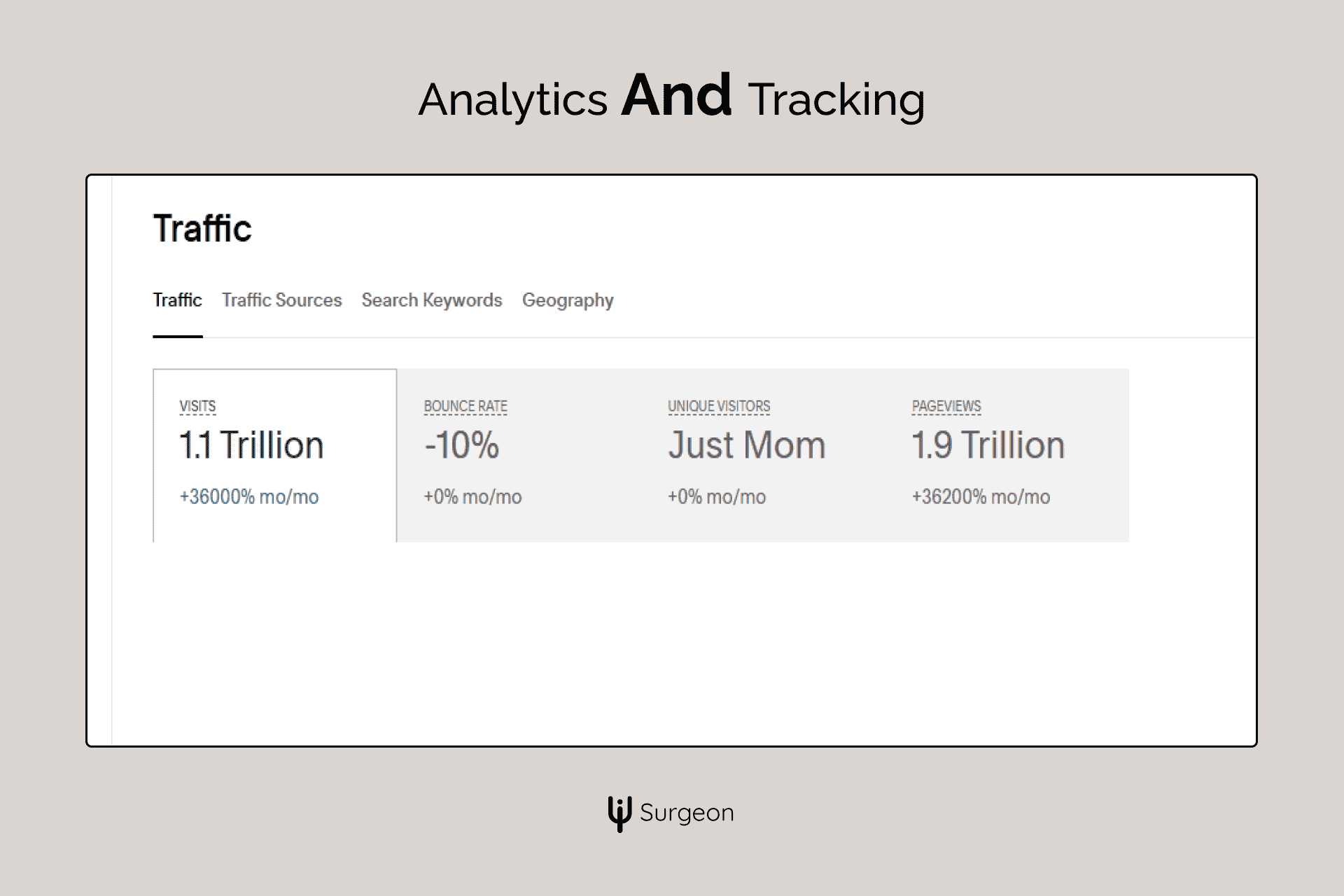
To optimize your blog’s performance, it’s crucial to set up robust tracking tools. Here are some essential analytics and tracking setups for your Squarespace blog:
1. Google Analytics Setup
Google Analytics 4 (GA4) is a powerful tool to track your blog’s traffic, user behavior, and performance of individual blog posts. To set it up on your Squarespace blog, follow these steps:
- Create a Google Analytics Account: If you haven’t already, sign up for Google Analytics and create a new property for your blog.
- Install GA4: In your Squarespace dashboard, go to Settings > Advanced > External API Keys. Enter your Google Analytics Measurement ID to connect GA4 to your site.
- Track User Behavior: GA4 provides insights into which pages users visit, how they interact with your content, and how long they stay. This data will help you identify your most popular posts and optimize the content that keeps readers engaged.
- Monitor Traffic: Track overall traffic trends, including sessions, bounce rates, and demographics. This allows you to adjust your content strategy based on what’s resonating with your audience.
2. Pinterest Verification
Pinterest is an excellent platform for driving traffic to your blog, especially if you’re creating engaging visual content like Pinterest pins. To track the effectiveness of your Pinterest content, it’s important to verify your site with Pinterest:
- Sign Up for Pinterest Analytics: First, create a business account on Pinterest to unlock advanced analytics features.
- Verify Your Website: Go to your Pinterest settings, enter your blog’s URL, and follow the instructions to verify your site. This will give you access to insights on how your Pinterest posts are performing, including click-through rates and engagement metrics.
- Track Pinterest Performance: By verifying your site, you can access detailed Pinterest analytics to see which pins are driving traffic, which boards are most popular, and how users are engaging with your content.
3. Tracking Affiliate Clicks
Affiliate marketing is an essential strategy for monetizing your blog, and tracking affiliate link performance is key to measuring success:
- Use Prettier Links: Although you don't have plugins like Pretty Links for Squarespace, you can still use Squarespace URL mapping to optimize affiliate links on your blog. This lets you create custom links that are easier to share and track, helping you monitor click-through rates and conversions.
- Optimize Link Placement: Use the performance data to strategically place your affiliate links in high-performing posts or in locations where readers are most likely to click, such as within actionable content or calls to action.
Implementing these tracking tags and features will allow you to optimize your blog and products based on user-interaction. Which is essential for data-driven decisions and business moves.
Pre-Launch Essentials for Your Squarespace Blog
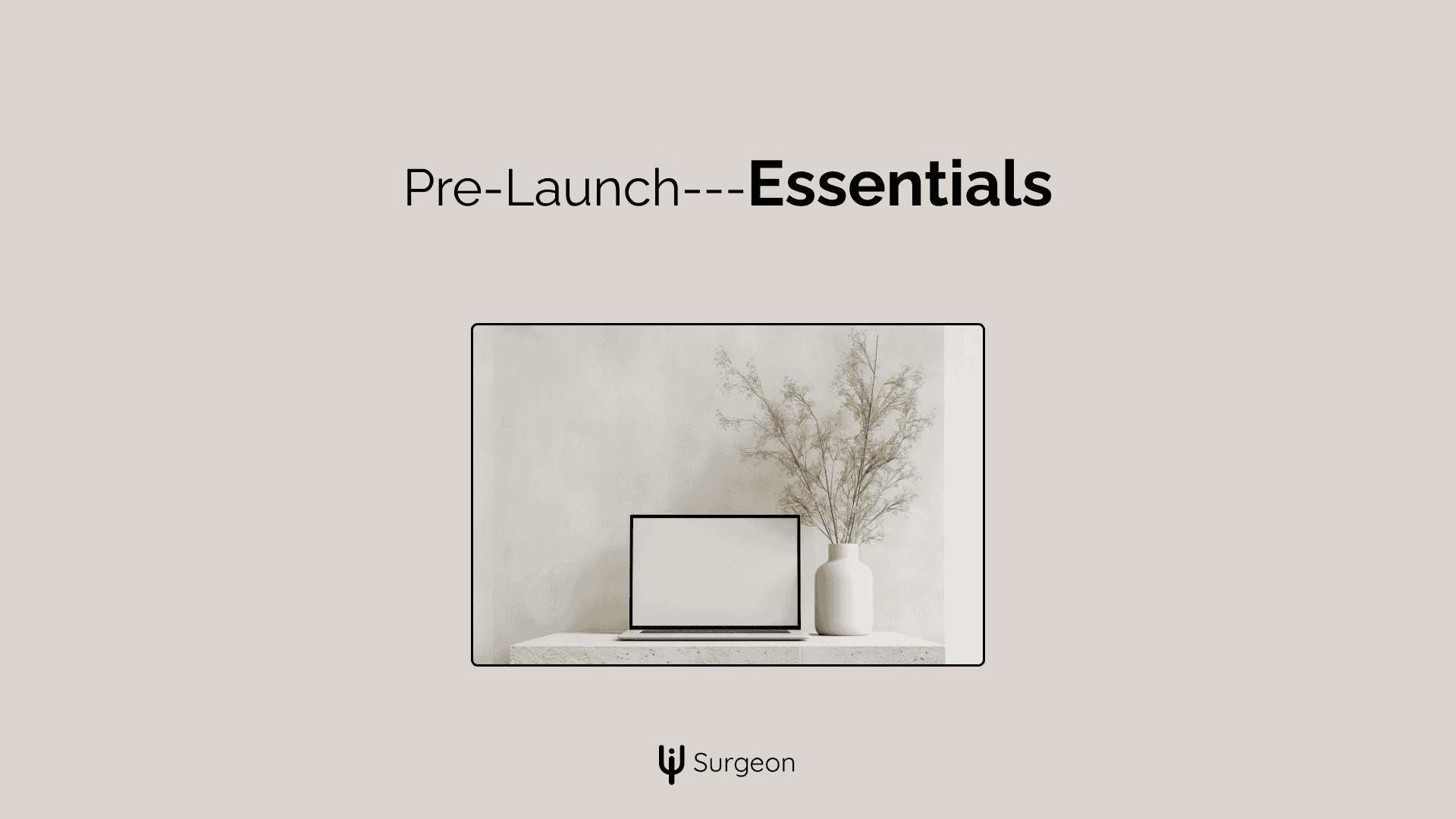
Before you hit that publish button, it's important to ensure your blog is polished, functional, and compliant. Here are a few essentials to check off your list:
1. Mobile Responsiveness Check
With so many users browsing on mobile devices, you’ll want to make sure your site looks great on all screen sizes. Take a moment to preview your blog on different devices and check that everything flows smoothly. If anything feels off, adjust your design until it’s just right.
It's rare to find problems with responsiveness using Squarespace templates.
2. Site Speed Optimization
Fast loading times are crucial for keeping visitors happy and improving your search engine rankings. A few simple tweaks, like compressing images can make a big difference in how quickly your site loads. The quicker it is, the better the experience for your readers.
Caesium Image Compressor is amazing for compressing your images before uploading them to Squarespace. Sometimes image size can be reduced by like 80% without affecting quality that much.
3. Affiliate Disclosure Placement
If you're pacing affiliate links on your blog posts it's best that you state that clearly in each blog post with affiliate links.
If you're not sure just place a discloser like this: "This post may contain affiliate links, meaning I may earn a commission if you make a purchase, at no extra cost to you.", indicating that it may or may not include affiliate links.
4. Legal Pages Setup
Your blog will need some important legal pages before launch. At least a Privacy Policy page.
Beginning, you're obviously not gonna hire a lawyer. You should use something like ChatGPT instead. Tell it what you do exactly, like affiliate links, commissions, cookies, promotional posts, and it will generate a privacy policy page for you. Just make sure everything is said correctly to avoid any legal complications.
Frequently Asked Squarespace Blogging Questions
How do I import my existing blog posts?
To import or export content in Squarespace, go to the "Import & Export Content" panel. Select your source (e.g., WordPress, Blogger, Shopify) to add blog posts, images, or products. For exporting, create an .xml or .csv file. Note that syncing content between sites or importing between two Squarespace 7 sites isn't supported.
Can I schedule blog posts in advance?
Yes, Squarespace has a built-in scheduling tool that allows you to set a date and time for your blog posts to go live.
What's the best way to organize blog categories?
To keep your blog organized and user-friendly, limit your categories to 5-7 core topics. This prevents clutter and ensures that your readers can easily navigate your blog and find relevant content without feeling overwhelmed.
How do I optimize my blog posts for SEO?
Optimizing your blog posts for SEO in Squarespace is all about focusing on key elements. Make sure your content is keyword-rich, and don’t forget to write compelling meta descriptions and use alt text for images. Additionally, be sure to implement internal linking to guide readers to other relevant content on your blog.
Can I customize my blog’s design?
Absolutely! Squarespace offers a variety of customization options for your blog's design, from templates to CSS tweaks. You can adjust the layout, colors, and fonts to fit your brand’s aesthetic or even add custom code for more advanced design changes.
How do I add social sharing buttons to my blog posts?
Adding social sharing buttons to your blog posts is easy in Squarespace. You can enable these through the "Social Links" section in your post settings, allowing readers to share your content on platforms like Facebook, Twitter, and Pinterest with just a click.
How do I monitor my blog’s performance?
To track your blog’s performance, you can integrate Google Analytics with your Squarespace site. This will give you detailed insights into traffic, user behavior, and which blog posts are performing the best, allowing you to fine-tune your strategy.
Conclusion
Success in blogging requires more than just great content—it needs a solid foundation, consistent effort, and strategic planning. With Squarespace's robust platform and the comprehensive strategies outlined in this guide, you're well-equipped to create and grow a successful blog.
Key steps to get started:
- Choose your plan based on your specific needs and goals
- Set up your domain and basic structure following our optimization guidelines
- Create your content strategy and initial posts
- Implement the technical and marketing strategies we've discussed
- Regularly review and adjust based on performance metrics
Remember to revisit this guide as you grow and evolve your blog. Each stage of your blogging journey will benefit from different aspects of these strategies.

